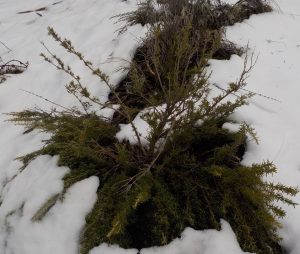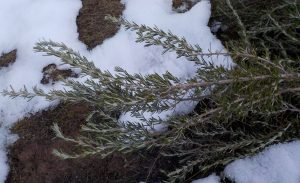Growing 迷迭香 [mídiéxiāng] Rosmarinus officinalis – rosemary
Three beautiful rosemaries are growing in front of my dwelling. Early this year they were covered by a thick pack of snow. They were the first plants that showed their green again once the snow began to melt.
We have been using rosemary for our stews and pasta sauces this winter, and I am happy that I can give it a place on the website. Their emergence from the snow was a great beginning of the year.
The Chinese name of rosemary, 迷迭香 [mídiéxiāng], means literally:
Repeatedly Enchanting Fragrance
Key information from the Chinese materia medica 中药大辞典 [Zhōngyào dà cídiǎn]:
Nature and flavour
acrid; warm (one source says: balanced); non-toxic
Actions and indications
fortifies the stomach
promotes sweating
treats (different kinds of) headache
one source says: calms the spirit
“There’s rosemary, that’s for remembrance; pray, love, remember”
(Ophelia in Shakespeare’s Hamlet).
Rosemary is used ritualistically to remember loved ones that have passed on (see also below).
The use of rosemary to enhance memory has been widely described throughout history and is practiced up to the present. In ancient Greece, scholars wore it around their necks or in their hair and stuffed it under their pillows at night, all to improve their memory. And a friend told me that in Israel, rosemary is planted in the gardens of universities for the same purpose.
Shamanistic usage is related to the plant’s ability to heal and ward off evil spirits. It is often planted in or around a ‘healing circle’.
From Egypt to Dioscorides to Sir Thomas More … & more
Here is a selection of articles that focus on the history of rosemary (I added a citation from each of them):
“Libanotis which the Romans call Rosmarinus & they which plait crowns use it: the shoots are slender, about which are leaves, small, thick, and somewhat long, thin, on the inside white, but on the outside green, of a strong scent. It hath a warming facultie . . .”
<<Citing Dioscorides, De Materia Medica, Book III: 89 A.D.>>
History of the Magical Rosemary Plant
“[…] rosemary was believed to grow only in the gardens of the righteous and
protected one from evil spirits.”
Rosemary, That’s for Remembrance
“[…] a universal symbol of remembrance used to honor those who have passed on. The tradition of laying sprigs of rosemary across the coffin or upon a tombstone dates back to ancient Egypt. ”
Rosemary: An Historic and Useful Herb
“[…] a plant that has been grown for over 5000 years (with dried sprigs found in Egyptian tombs from 3000 B.C.E.), […]”
Medicinal – Chinese medicine
For more information in English on the medicinal use of rosemary, especially related to Chinese medicine, please see:
- The Energetics of Western Herbs, by Peter Holmes (pp. 340-342 in the third edition)
- Combining Western Herbs and Chinese Medicine, by Jeremy Ross (pp. 635-650)
- Western Herbs in Chinese Medicine – Methodology and Materia Medica, by Thomas Avery Garran (pp. 285-290)
Here is the (somewhat abbreviated) entry on rosemary from 中药大辞典 :
【药材名称】迷迭香
【拼音】mí dié xiānɡ
【出处】《本草拾遗》<The 本草拾遗 – Běncǎo shíyí was first published in the 開元 period of the Tang dynasty (713—741).>
【来源】为唇形科植物迷迭香的全草。5~6月采收。
【原形态】常绿小灌木,高约1~2米,有纤弱、灰白色的分枝,全株具香气。叶对生,无柄;叶片线形,革质,长约3.4厘米,宽约2~4毫米,上面暗绿色,平滑,下面灰色,被毛茸,有鳞腺,叶缘反转,下面主脉明显。花轮生于叶腋,紫红色,唇形;萼钟状,2唇形,有粉毛;花冠2唇,筒部短,喉部广阔,上唇2瓣,下唇3裂,大型,凹面有紫点;雄蕊仅前方1对发育;子房2室,花柱微超出上唇外侧。小坚果4,平滑,卵球形。花期4~6月。
【生境分部】原产南欧各国;我国亦有栽培。
【化学成分】全草(叶及枝)含芹菜素-7-葡萄糖甙、木犀草素-7-葡萄糖甙、5-羟基-4′,7-二甲氧基黄酮、4′,5-二羟基-7-甲氧基黄酮、鼠尾草苦内酯、鼠尾草酸、迷迭香碱、异迷迭香碱、表-α-香树脂醇、α-香树脂醇、β-香树脂醇、白桦脂醇、熊果酸、19α-羟基熊果酸、2β-羟基齐墩果酸等以及β-谷甾醇。
枝、叶中含有抗菌作用的挥发油0.48~0.52%,其中含α-菰烯、莰烯、1,8-桉叶素、龙脑、樟脑α-和β-松油醇、松油烯-4-醇、马鞭烯醇、乙酸龙脑酯等。
此外,还发现有香叶木甙、迷迭香酸和唇形草鞣质酸。唇形草鞣质酸为咖啡酸与α-羟基氢化咖啡酸的缩酚羧酸,它和上述的鼠尾草酸均有抗氧化作用。
【药理作用】迷迭香制剂在妇科中可用作催经药,对更年期的神经紊乱所引起的月经过少或停经,可用此加速月经来潮。有慢性胆囊瘘的狗以迷迭香碱5~10毫克/公斤静脉注射,能促进胆汁的排泄。迷迭香碱还能加强大脑皮层的抑制过程,有催眠、抗惊厥作用。5~20毫克/公斤可降低麻醉猫的血压,此乃由于对心脏的抑制及扩张血管所致。它还能防止大鼠的实验性胃溃疡,其毒性不大。
迷迭香叶的挥发油对金黄色葡萄球菌、大肠杆菌、霍乱弧菌等有肯定的抗菌作用,效力是中等度的。与蜀葵根作成的混合油剂可促进头发的生长。迷迭香中所含香叶木甙能降低兔毛细血管渗透性,作用比芦丁强。对毛细血管脆性增加的治疗效果比芦丁好,并且毒性低。
【性味】①《本草拾遗》:”辛,温,无毒。”
②《海药本草》:”平。”
【功能主治】健胃,发汗。治头痛。
①《本草拾遗》:”主恶气。”
②《国药的药理学》:”芳香健胃,亢进消化机能。”
③《中国药植图鉴》:”强壮,发汗,健胃,安神。能治各种头痛。和硼砂混合作成浸剂,能防止早期秃头。”
【用法用量】内服:煎汤,1.5~3钱。外用:浸水洗。
【摘录】《中药大辞典》

![迷迭香 [mídiéxiāng] – rosemary](https://ovingchinesemedicine.com/blog/wp-content/uploads/2017/01/rosemary-2017-A-863x555.jpg)


![歐當歸 [Ōudāngguī] – lovage](https://ovingchinesemedicine.com/blog/wp-content/uploads/2017/01/lovage-header-863x369.jpg)



![Growing 桔梗 [jiégěng]](https://ovingchinesemedicine.com/blog/wp-content/uploads/2017/01/jiegeng-collage-B-863x231.jpg)

![Growing 枸杞 [gǒuqǐ]](https://ovingchinesemedicine.com/blog/wp-content/uploads/2017/01/gouqi-collage-A-863x347.jpg)